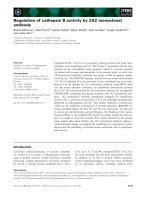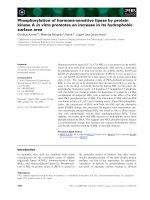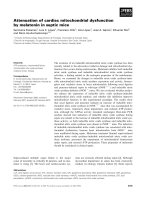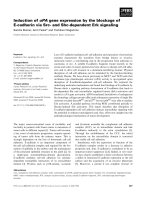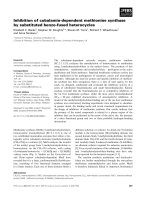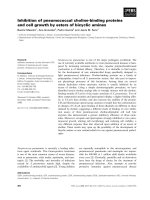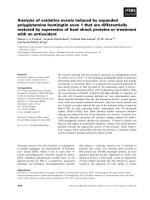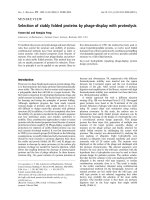Tài liệu Báo cáo Y học: Inhibition of nuclear pre-mRNA splicing by antibiotics in vitro pot
Bạn đang xem bản rút gọn của tài liệu. Xem và tải ngay bản đầy đủ của tài liệu tại đây (363.46 KB, 9 trang )
Inhibition of nuclear pre-mRNA splicing by antibiotics
in vitro
Maren Hertweck, Reinhard Hiller and Manfred W. Mueller
Vienna BioCenter, Institute of Microbiology and Genetics, Vienna, Austria
A number of antibiotics have been reported to disturb the
decoding process in prokaryotic translation and to inhibit
the function of various natural ribozymes. We i nvestigated
the eect of several antibiotics on in vitro splicing of a
eukaryotic nuclear pre-mRNA (b-globin). Of the eight
antibiotics studied, erythromycin, Cl-tetracycline and
streptomycin were identi®ed as splicing inhibitors in nuclear
HeLa cell extract. The K
i
values were 160, 180 and 230 l
M
,
respectively. Cl-tetracycline-mediated and streptomycin-
mediated splicing inhibition were in the molar inhibition
range for hammerhead and human hepatitis d elta virus
ribozyme self-cleavage (tetracycline), of group-I intron self-
splicing (streptomycin) a nd inhibition of RNase P cleavage
by some am inoglycosides. Cl-tetracycline a nd the amino-
cyclitol glycoside streptomycin were found to have an
indirect eect on splicing by unspeci®c binding to the
pre-mRNA, s uggesting that t he inhibition is the r esult of
disturbance of t he correct foldin g o f the pre-mRNA into the
splicing-compatible tertiary structure by the charged groups
of these antibiotics. The macrolide, erythromycin, the
strongest inhibitor, had only a slight eect on formation o f
the presplicing complexes A and B, but almost completely
inhibited formation of the splicing-active C c omplex by
binding to nuclear extract component(s). This results in
direct inhibition of the second step of pre-mRNA splicing.
To our knowledge, this is the ® rst report on s peci®c
inhibition of nuclear splicing by an a ntibiotic. The func-
tional g roups involved in the interaction of erythromycin
with snRNAs and/or splicing factors require further
investigation.
Keywords:
1
erythromycin; C l-tetracycline; nuclear splicing
inhibition; spliceosomal complex C.
Recognition o f nuclear mRNA precursors (pre-mRNAs) by
heterogeneous nuclear RNPs in¯uences the s ubsequent
assembly of the spliceosome [1]. The spliceosome is a
multicomponent complex consisting of ®ve different snR-
NAs and a large number of spliceosomal and nonspliceos-
omal proteins which assemble on the pre-mRNA before the
splicing reaction is started. Although the snRNAs are
thought to be the catalytically essential participants in
splicing, accompanying proteins are necessary for
co-ordinating and regulating spliceosome assembly and
the splicing reactions themselves [2±4]. Spliceosome assem-
bly is a multistep process, and n ative gel analysis has been
employed to detect the f ormation of four distinct spliceo -
somal complexes termed E, A, B and C [5±7]. Complex E
includes U 1 snRNP bound to the nascent pre-mRNA, while
complex A contains U1 as well as U2 snRNP bound to the
pre-mRNA. Complex B represents a precatalytic assembly
in whic h the U4/U6 hybrid and the U5 s nRNP have joined
the complex, but where interactions between the s plicing
factors required for catalysis have not yet occurred (e.g. U2/
U6 base pairing). Complex C represents the catalytically
active stage in which intron r emoval from pre-mRNA by a
two-step transesteri®cation reaction occurs.
The ®rst step of nuclear p re-mRNA splicing is g overned
by a nucleophilic attack of the 2¢ OH of the branch
adenosine at the 5¢ splice site. The 5¢ exon is released and the
splicing intermediate, t he lariat)3¢ exon, is for med. The
second step involves a nucleophilic attack of the terminal
3¢ OH of the 5¢ exon at the 3¢ splice site leading to the
formation of ligated exons and the excised intron RNA in
lariat form [8±10].
It has been demonstrated that several a ntibiotics act as
inhibitors of various biological RNA-catalyzed key pro-
cesses. The binding of antibiotics t o different functional
RNAs may result from r ecognition o f e lectrostatic comple -
mentary and evolutionarily conserved tertiary structure
motifs, which can lead to impairment or l oss of R NA
function [11,12]. Recently, two t ypes of aminoglycoside
antibiotic-binding sites on RNA have been proposed.
Type-I binding sites c onsist of a symmetric internal loops
as in the r ibosome-decoding site, a t which the a minoglyco-
sides induce slight distortion of the RNA structure and
interfere with the binding o f the functional sub strate.
Type-II binding sites are the central metal ion-binding pock-
ets i n the catalytic cores of ribozymes. In type-II binding
sites the aminoglycosides act by displacing es sential bivalent
metal ions via their positively c harged groups [13,14].
The best known example of an inhibitory actio n by
antibiotics in vivo is the inhibition of prokaryotic protein
synthesis [15±18]. For instance, macrolide antibiotics, espe-
cially erythromycin (Fig. 1 A), are supposed to inhibit
translation in bacteria by interacting with RNA and protein
components o f t he 50S ribosomal subunit. An effect on the
peptidyltransferase reaction a nd prevention of positioning
of the peptidyl-tRNA in the peptidyl site (P site) is the
consequence [19±21]. Macrolides are also known to inhibit
the initial step of 50S subunit assembly in g rowing bacter ia
[22±24]. The a minocyclitol glycoside s treptomycin (Fig. 1B)
Correspondence to M. W. Mu eller, VBC Genomics, Bioscience
Research GmbH, Rennweg 95B, A-1030 Vienna, Austria.
Fax: + 43 1 7966572 21, Tel.: + 43 1 7966572 20,
E-mail:
(Received 1 6 August 2001, revised 22 October 2001, accepted 29
October 2001)
Eur. J. Biochem. 269, 175±183 (2002) Ó FEBS 2002
as well as tetracyclines (Fig. 1C) inhibit bacterial translation
by interacting with the 30S ribosomal subunit. Streptomycin
induces misreading of the genetic code. It binds to four
different parts of 16S rRNA, i.e. close to the decoding site,
and makes contact with protein S12, affecting codon±
anticodon interaction and proofreading [ 18,25,26]. Tetracy-
clines in duce c onformational changes in the 30S subunit by
interfering with t he binding of tRNA to both the ribosomal
aminoacyl s ite (A site) and t he P site [ 18,27]. 16S RNA and
the proteins S4, S7, S9 and S17 are thought to be essential
components of the strong binding sites o f tetracyclines on
the 3 0S subunit [ 28±30]. Furthermore, man y aminoglyco-
sides and tetracyclines are known to i nhibit the catalytic
activity of self-splicing group-I and group-II introns, self-
cleaving hammerhead a nd h airpin r ibozymes, t he human
hepatitis delta virus and HIV-1 ribozymes, and tRNA
processing RNase P RNAs in vitro [11,31±35]
(M. Hertweck, R. Hiller & M.W. Mueller, unpublished
work)
2
. However, in vitro inhibition of nuclear pre-mRNA
splicing by any antibiotic has not been described s o far.
Here, we report on the inhibitory actions of erythromy-
cin, Cl-tetracycline a nd streptomycin on nuclear splicing of
the second b-globin intron in nuclear HeLa cell extract.
Denaturing and native g el a nalyses provided information
about the nature of the splicing inhibition, especially on
which component o f the nuclear splicing reaction, the pre-
mRNA or the nuclear extract containing the snRNAs and
associated splicing factors, the antibiotics exert t heir action.
Of the antibiotics tested, only the macrolide erythromycin
was fou nd to have a direct effect on splic ing. Formation of
the spliceosomal complexes A and B was slightly reduced
and formation of complex C was completely inhibited by
erythromycin, resulting in speci®c inhibition of the second
step of pre-mRNA splicing. This ®nding, together w ith
recent data on macrolide-mediated inh ibition of eukaryotic
pre-mRNA transcription factor activation in vivo,suggest
that erythromycin interferes with at least two major stages
of eukaryotic gene expression, transcription i nitiation and
pre-mRNA splicing.
MATERIALS AND METHODS
Plasmid and oligonucleotides
The pre-mRNA b-globin, derived from the second b-globin
intron of rabbit pre-mRNA ( 573 nucleotides), ¯anked by
the corresponding 5 ¢ exon sequence ( 105 nucleotides) and
3¢ exon sequence (45 nucleotides), was used to assay pre-
mRNA splicing. To construct the plasmid KS+/b-globin,
the i ntron p lus ¯anking exons of genomic rabbit DNA was
ampli®ed by PCR techniques. For PCR, the primers b-glb1/
P(5¢-AATCTGGTACCTCACCTGGACAACCTCAAA-
3¢)andb-glb2/M (5¢-AATAAGAATTCGCCAAAAT
GATGAGACAGCA-3¢) were used. The product was
cloned between the KpnIandEcoRI site of the bluescript
phagemid vector KS+. The c loning step has been con-
®rmed by dideoxy sequencing with the KS+-speci®c T3
primer.
In vitro
transcription
The b-globin pre-mRNA was prepared from EcoRI-linea-
rized KS+/b-globin using T3 RNA polymerase. Template
DNA (5 lg) was transcribed in a 200-lL volume containing
2.5 m
M
each NTP, 8 m
M
MgCl
2
,2m
M
spermidine, 4 0 m
M
Tris/HCl, pH 8.0, 50 m
M
NaCl, 30 m
M
dithiothreitol and
250 U T3 RNA polymerase. The RNA was internally
labeled b y t he addition of [a-
32
P]UTP to t he in v itro
transcription a ssay. Freshly transcribed pre-mRNA was
puri®ed by electrophoretic separation on a denaturing 5%
polyacrylamide (30 : 1) 8
M
urea gel
3
and eluted from the gel
after UV-shadowing.
In vitro
splicing assays
Standard splicing of the b-globin pre-mRNA in HeLa
nuclear extract was per formed at 30 °C for 60 min. Splicing
reactions were prepared in a 10-lL volume u sing the
following standard conditions: 40% (v/v) H eLa nuclear
Fig. 1. Struc tural drawings of the antibiotics
investigated in nuclear splicing i nhibition. (A)
The macrolide e rythromycin containing a
14-membered m acrolide rin g with a t ypical
lactone group (framed) and two sugars,
D
-desosamine (top) and
L
-cladinose (bottom).
(B) T he aminocyclitol g lycoside streptomycin
with a s treptidine ring as the main building
block: 1,3-diguanidinoinositol. (C) Te tra-
cycline consisting of four f used rings. The
hydrogen at position 7 in tetracycline is
replaced by chlorine in Cl- t etracycline.
176 M. Hertweck et al.(Eur. J. Biochem. 269) Ó FEBS 2002
extract (Promega), 5 m
M
Hepes (pH 7.9), 3 m
M
MgCl
2
,
20 m
M
creatine p hosphate, 400 l
M
ATP, 0.6% polyv inyl
alcohol, 18 U RNase inhibitor, 50 fmol pre-mRNA, a nd
antibiotic at concentrations indicated in the ®gures. Reac-
tions were stopped b y the addition of HeLa nuclear extract
stop mix (Promega). The mixture was then extracted with
phenol/chloroform/isoamyl alcohol (39 : 59 : 2, v/v), and
the aqueous phase ethanol precipitated. After a washing
step, the pellets were resuspended in f ormamide-containing
gel-loading dye, a nd the p roducts separated on denaturing
5% polyacrylamide (30 : 1) 8
M
urea gels. The products
were analyzed on a Molecular D ynamics P hosphorImager.
The sum of the four fractions, lariat)3¢ exon, excised lariat,
ligated exons and pre-mRNA, was de®ned as 100% educt
plus product.
For a nalysis of spliceosomal complexes, splicing reaction
mixtures were loaded directly on to a native gel consisting of
3% polyacrylamide (100 : 1)
4
/0.5% a garose, 0.5 ´ Tris/
borate/EDTA (pH 8.5), and run in 0.5 ´ Tris/borate/
EDTA at 4W for 16h at 4°C. The complexes were
analyzed on a Molecular Dynamics PhosphorImager. The
gel w as then exposed to ®lm at )80 °C w ith a n intensifying
screen.
Band-shift assay
Sense or antisense b-globin pre-mRNA (50 fmol) was
incubated with 500 l
M
antibiotic in a ®nal v olume of 10 lL
under the following conditions: 5 m
M
Hepes (pH 7.9),
480 l
M
MgCl
2
,20m
M
creatine ph osphate, 400 l
M
ATP,
0.6% polyvinyl alcohol and 5% glycerol. Reactions were
carried out at 30 °C for 15 min, and the mixtures put on i ce
and loaded o n to a native 5% polyacrylamide (50 : 1),
50 m
M
Tris/glycine (pH 7.5) gel and run in 50 m
M
Tris/
glycine at 12 W for 3 h at room temperature. The gel was
analyzed as described above.
Kinetic analyses
b-Globin s plicing over 0±60 min was followed in the
absence and presence of various concentrations of antibiotic
(0, 50, 100 , 250, 500 l
M
). Reactions were carried out
as described for in vitro splicing assays and gels were
scanned on a PhosphorImager. The fraction inhibition
at each antibiotic concentration was calculated from the
rates of pre-mRNA t urnover for the antibiotic reaction
(k
AB(antibiotic)
) and the corresponding control reaction
[kcon(control without AB)] from the relationship
1 ) k
AB
/k
con
. The values of 1 ) k
AB
/k
con
vs. antibiotic
concentration were ®tted to a binding equation, giving an
inhibition constant, K
i
, for splicing inhibition as described
previously [31].
RESULTS
Erythromycin, Cl-tetracycline and streptomycin inhibit
nuclear splicing
in vitro
The effects of eight different antibiotics (the aminoglycoside,
kanamycin, the a minocyclitol glycoside, streptomycin, t he
penicillins, ampicillin and penicillin G, the aminocyclitol,
spectinomycin, tetracycline and Cl-tetracycline, and the
macrolide, erythromycin) on n uclear b-globin splicing in
HeLa nuclear extract were investigated ( Fig. 2A). Antibiotic
was added to the splicing reaction mixture at a concentra-
tion of 450 l
M
. Kanamycin and penicillin G ( Fig. 2A, lanes
4 and 8) showed no effect on pre-mRNA splicing, whereas
ampicillin and spectinomycin (lanes 6±7) had a s light
enhancing effect. Some 60% of the b-globin pre-mRNA
was converted into excised lariat RNA in the presence of the
latter two antibiotics, compared with 47% excised lariat
formed in the control without antibiotic. Tetracycline
showed a slight inhibitory effect on pre-mRNA splicing,
as indicated by a reduction in excised lariat RNA by 9%
only (lane 3). T he other three antibiotics, Cl -tetracycline,
streptomycin and erythromycin, are clearly inhibitors of
nuclear pre-mRNA splicing, as indicated by a large
reduction in excised lariat R NA and a corresponding
amount of unchanged pre-mRNA, respectively (lanes 2, 9
and 5).
The t hree inhibitory antibiotics and tetracycline were
tested in the concentration range 0±5 00 l
M
(Fig. 2B,C).
Conversion of pre-mRNA into excised lariat RNA was
reduced by 60% in the presence of 500 l
M
Cl-tetracycline
and by 95% in t he presence of 500 l
M
erythromycin and
streptomycin (Fig. 2B,C). Tetracycline at 500 l
M
inhibited
splicing by only 1 0% (Fig. 2B,C), c on®rming that it is
negligible. The different r esults obtained f or Cl-tetracycline
and tetracycline suggest an important role for the chlorine
group in inhibition.
Splicing in the presence of Cl-tetracycline a nd strepto-
mycin r esulted i n a general r eduction in pre-mRNA
turnover (Fig. 2A,B, lanes 1±4 and 11±13). Splicing inhibi-
tion by erythromycin, the strongest in hibitor observed, led
to the accumulation of the splicing intermediate l ariat
)3¢ exon being almost as abundant as the excised lariat
RNA (Fig. 2D, as shown in Fig. 2A, lane 5 and Fig. 2B,
lanes 8 ±10). This i ndicates that e rythromycin may ha ve a
direct effect on catalysis by speci®cally inhibiting comp o-
nent(s) of the nuclear splicing apparatus involved particu-
larly in the second transesteri®cation step of splicing.
Like ribozymes, the nuclear splicing apparatus also
includes bivalent metal ions, especially Mg
2+
ions, for
stabilization of the spliceosome structure and catalysis,
despite the accompanying protein factors [2 ,36,37]. To
investigate whether splicing i nhibition is based on compe-
tition of the antibiotic s with Mg
2+
ions, Mg
2+
competition
experiments u sing 500 l
M
antibiotic and 3±10 m
M
Mg
2+
(3 m
M
Mg
2+
employed for standard splicing, see Materials
and methods and [38]) were performed (Fig. 3). The
experiments indicated interference of Mg
2+
with the
inhibitory action of streptomycin only. An increase in
Mg
2+
concentration to 1 0 m
M
completely reversed s tre p-
tomycin-mediated splicing inhibition (Fig. 3). This may
suggest that streptomycin competes with Mg
2+
ions for
binding to the nuclear splicing apparatus. The inhibitory
effect of erythromycin and Cl-tetracycline were not allevi-
ated by Mg
2+
(Fig. 3).
Kinetic analyses using increasing concentrations of
erythromycin, Cl-tetracycline and streptomycin up to
500 l
M
were performed. The concentration required to
inhibit 50% of pre-mRNA splicing in HeLa nuclear extract
(K
i
) was determined for each a ntibiotic ( see Mate rials and
methods and [31]). The K
i
for erythromycin was
160 12 l
M
, t hat for Cl-tetracycline was 180 9 l
M
,
and that for streptomycin was 230 32 l
M
.
Ó FEBS 2002 Nuclear splicing inhibition by antibiotics (Eur. J. Biochem. 269) 177
The c ourse of inhibition by Cl-tetr acycline was sim ilar t o
that by erythromycin (the course refers to titration of
antibiotic incubated for 60 min; Fig. 2C). A distinct course
of inhibition was exhibited b y streptomycin. An extended
delay phase up to a concentration of 150 l
M
was followed
by a burst phase leading to complete inhibition at 500 l
M
streptomycin (K
i
230 l
M
) (Fig. 2C). The course of inhibi-
tion is in line with the suggestion that streptomycin
competes with Mg
2+
ions for binding to the nuclear
splicing apparatus.
Cl-tetracycline and streptomycin, in contrast
with erythromycin, have different targets
for inhibitory action
We investigated on which component of the nuclear splicing
reaction, the b-globin pre-mRNA or t he HeLa nuclear
extract containing the snRNAs and associated splicing
factors, the antibiotics exhibit their inhibitory action
(Fig. 4). For this, we designed preincubati on assays. In the
®rst preincubation assay (Fig. 4A), the HeLa nuclear
extract was preincubated with 500 l
M
Cl-tetracycline,
streptomycin or erythromycin for 1 5 min at 30 °Cinthe
absence of pre-mRNA, followed by the addition of pre-
mRNA in prewarmed buffer (30 °C) and incubation for 1 h
at 30 °C. The splicing ef®ciencies were calculated from the
percentage of the excised lariat fraction. With Cl-tetracyc-
line, preincubatio n resulted in a 4 0% diminished inhibitory
effect, compared w ith t he reaction without preincubation
(Fig. 4A). For streptomycin the decrease in splicing inhibi-
tion was 12% (Fig. 4A). This indicates that these antibiotics
do not inhibit nuclear s plicing by b inding to factor(s) of t he
nuclear extract. The same e xperiment u sing erythromycin
showed the opposite effect. Splicing inhibition was increased
by 90% after preincubation (F ig. 4A), suggesting that
erythromycin binds to factor(s) of t he HeLa extract e ven in
the absence of pre-mRNA.
In the inverse preincubation experiment, the poten tial
binding of Cl-tetracycline, streptomycin and erythromycin
to b-globin pre-mRNA (Fig. 4B) was examined. The pre-
mRNA was preincubated with the antibiotics before
being mixed with the other components. The d ata
con®rmed the possible binding of Cl-tetracycline a nd
streptomycin to the pre-mRNA. With Cl-tetracycline
and s treptomycin, the preincubation resulted in a 65%
and 46% increase in splicing i nhibition, compared with
the r eaction without preincubation (Fig. 4B). In c ontrast,
preincubation with erythromycin resulted in a 20%
decrease in splicing inhibition (Fig. 4B), con®rming that
erythromycin does n ot inhibit nuclear splicing by binding
to the pre-mRNA.
Next we looked at the potential interaction of erythro-
mycin w ith factor(s) of the nuclear extract in m ore detail
(Fig. 4C). Erythromycin (0, 300 l
M
or 500 l
M
)wasincu-
Fig. 2. Sp licing inhibition of the b-globin i ntron by several an tibiotics. (A) Eect of eight dierent antibiotics on nuclear splicing. b-globin splicing
employing 50 fmol of internally a-
32
P-labeled pre-mRNA was performed under st andard splicing cond itions at 30 °C for 60 min. Lane 1, no
addition of an tibiotic (±); lanes 2±9, in the presence of 450 l
M
antibiotic. CTC, C l-tetracycline; Tet, tet racycline; Kan, kanamycin; Ery, erythro-
mycin; Amp, ampicillin; Spec, spectinomycin; Pen, penicillin G; Strep, streptomycin; L-3¢Ex, lariat)3¢ exon ; L, lariat; Prc, mRNA precursor. (B)
Inhibition of b-globin splicing by Cl-tetracycline, tetracycline, erythromycin and streptomycin, shown in the presence of 0 l
M
(±), 100, 250 or
500 l
M
antibiotic. Reactions were performed as described in (A). Bands are labeled as in (A). (C) Results from (B) plotted as a graph. Th e eciency
of lariat formation ( %) is plotted as a function of increasing concentrations of antibiotic (l
M
). (D) Inhibition o f b-globin s plicing by increasing
concentratio ns of e ryth romycin. The eciency of lariat)3¢ ex on and lariat formation (%) is ill ustrated as a function o f erythromycin ( l
M
). The
®gure represents means SEM from four independent experiments.
178 M. Hertweck et al.(Eur. J. Biochem. 269) Ó FEBS 2002
bated at 30 °C under standard splicing conditions for
60 min. As a control, half of each set up w as stopped
(undiluted r eaction) and t he remainder adjusted to the ®nal
reaction volume with HeLa nuclear e xtract and splicing
buffer; the incubation was then c ontinued for 30 min
(diluted r eaction). The data revealed that splicing i nhibition
by erythromycin (undiluted reaction) is signi®cantly dim in-
ished by a 1 : 1 dilution with nuclear extract and buffer
(diluted r eaction) by a factor of 2±5, resulting in 58% lariat
formation when c ompared w ith t he respective control
reaction (Fig. 4C). As the r atio between pre-mRNA and
erythromycin in the undiluted and diluted reaction is
constant, the result of signi®cant reduction in splicing
inhibition indicates t hat erythromycin does not inh ibit
nuclear splicing b y interacting with the pre-mRNA. Thus,
this ®nding is consistent with the idea t hat erythromycin
interacts speci®cally with one or several components of the
nuclear extract.
The suggested inhibitory interaction between Cl-tetracyc-
line or streptomycin and the pre-mRNA was further
investigated in a band-shift assay ( Fig. 5), in which the
af®nity of all three inhibitory antibiotics for sense a nd
antisense b-globin pre-mRNA was analyzed. The gel-
puri®ed sense a nd antisense RNAs showed main confor-
mation(s) without antibiotic as well as several other less
prominent native bands in the middle or lower area of the
gel (Fig. 5, lanes 1 and 2). The addition of Cl-tetracycline
and streptomycin to both RNAs r esulted in a change in the
native band pattern. Detectable upward band shifts (lanes 3,
4 and 6) as well as the appearance of a very s trong and
compact main conformation (lane 5 ) w ere observed . The
middle and lower bands disappeared in the presence of
Cl-tetracycline a nd strepto mycin. The observation that
changes in the band pattern occurred with both sense and
antisense R NAs, wh ich have similar secondary structures
but complementary primary sequences and different tertiary
structures, implied that C l-tetracycline and streptomycin
interact unspeci®cally with b-globin RNA.
Incubation of sense a nd antisense RNA with erythromy-
cin did not result in any change in the electrophoretic
mobility in n ative gel systems (Fig. 5, lanes 7 and 8 ). This is
Fig. 4. Cl-te tracycline and streptomycin have a dierent target for
inhibitory action from that observed for erythromycin. (A) Preincuba-
tion assay. Eect on splicing i nhibiton by preincubation of H eLa
nuclear extract with 500 l
M
Cl-tetracycline ( CTC), streptomycin
(Strep)orerythromycin(Ery),comparedwithacontrolreaction(±)
without antibiot ic. ( B) Inverse preincubation assay. Eect o f splicing
inhibition by preincubation of the b-globin pre-mRN A with 500 l
M
CTC, Strep o r Ery, compared with a control r eactio n (±) without
antibiotic. (C) Signi®cant reduction in erythromycin-mediated sp licing
inhibition by a 1 : 1-dilution of b-globin pre-mRNA and antibiotic
(0, 300 or 500 l
M
Ery) with nuclear extract and buer. The ®gure
represents means SEM f rom three independent experiments.
Fig. 3. In terference of Mg
2+
with the inhibitory action of streptomycin
analyzed by Mg
2+
competition experiments. Reactions were performed
as described in Fig. 2A using 500 l
M
streptomycin (Strep), Cl-tetra-
cycline (CTC) or erythromycin (Ery) and increasing concentrations of
MgCl
2
(3, 6 and 10 m
M
MgCl
2
), compared with a control reaction (±)
without antibiotic. The ®gure represents means SEM f rom two
independent experiments.
Ó FEBS 2002 Nuclear splicing inhibition by antibiotics (Eur. J. Biochem. 269) 179
in agreement with the idea that erythromycin does not
interact directly with the pre-mRNA. Thus, the inhibitory
effect on splicing may result from interaction of this
antibiotic with RNA a nd/or protein component(s) o f the
nuclear extract as suggested above.
Erythromycin completely inhibits spliceosomal
complex C formation
Next we investigated which spliceosomal complex is nega-
tively affected by the action o f erythromycin (Fig. 6).
Formation of the four different spliceosomal complexes E,
A, B and C was identi®ed in a time course splicing a ssay
using native gel systems (Fig. 6, lanes 1±4). Complex C,
representing the c atalytically active splicing c omplex, w as
formed after 20 min (lanes 3 and 4) . The ident ity of the
respective complexes was veri®ed independently by gel
extraction followed b y denaturing g el electrophoresis wh ere
the corresponding b-globin splicing educt and products were
detected (not shown).
Adding erythromycin in increasing concentrations (300,
600 and 900 l
M
) to t he 30 min s plicing r eaction resulted in
inhibition of spliceosome assembly. Formation of the
presplicing complexes A and B was slightly reduced by
increasing concentrations of erythromycin (lanes 5±7).
Interestingly, formation of complex C, in which the catalytic
steps o f s plicing o ccur, was strongly affected (lanes 5±7). In
detail, 300 l
M
erythromycin resulte d in formation of lo w
levels of complex C (lane 5). When the c oncentration o f
erythromycin was increased to 600 and 900 l
M
, formation
of complex C was almost completely ( lane 6) or completely
(lane 7) inhibited. This is in line with t he large r eduction in
pre-mRNA turnover with increasing concentrations of
erythromycin (cf. Figure 2B).
DISCUSSION
In this study, three antibiotics, erythromycin, Cl-tetracycline
and s treptomycin, were identi®ed in vitro as inhibitors of
nuclear b-globin pre-mRNA splicing ( Fig. 2). They are
members o f t hree different classes o f antibiotic: macrolides,
tetracyclines and aminoglycosides. Of the antibiotics tested,
erythromycin was found to be the strongest inhibitor. The
K
i
values for erythromycin, Cl-tetracycline and streptomy-
cin were f ound to be in the m icromolar range (160, 180 and
230 l
M
, respectively). The K
i
values are similar to those
observed in tetracycline-mediated inhibition of the s elf-
cleavage reaction in hammerhead and human hepatitis
delta virus ribozymes [33,39], the streptomycin-mediated
inhibition of group-I intron self-splicing [11], and some
aminoglycoside class-mediated inhibitions of RNase P
cleavage [35].
Fig. 5 . An i ty of Cl-tetracycline (CTC; lanes
3±4), streptomycin (Strep; lanes 5±6) and ery-
thromycin (Ery; la nes 7±8) f or the s ense and
antisense b-globin pre-mRNA analyzed by a
band-shift assay. Each antibio tic (500 l
M
)was
incubated with the RNA [sense (S) or an ti-
sense (A)] at 30 °C for 15 min. The samples
were separated on a native 5% polyacrylam ide
(50 : 1)/50 m
M
Tris/glycine gel. The native
patterns obtained were compared with those
without antibiotic (±) (lanes 1and 2). b and-
shift, area of upward band-shift; main, m ain
conformation(s); middle, bands in the m iddle
area of the g el; lower, bands in th e lower area
of the g el .
180 M. Hertweck et al.(Eur. J. Biochem. 269) Ó FEBS 2002
Cl-tetracycline and streptomycin have an indirect
effect on splicing
With Cl-tetracycline and streptomycin, a general reduction
in b-globin p re-mRNA t urnover was observed (Fig. 2).
Results obtained in preincubation assays (Fig. 4) indicated
that these antibiotics affect splicing by binding to the pre-
mRNA. Their interaction with factor(s) of the HeLa nuclear
extract could b e excluded ( Fig. 4B). A band-shift assay
using sense and antisense b-globin pre-mRNA (Fig. 5)
suggested an unspeci®c interaction of these antibiotics with
b-globin R NA.
The data i mply that Cl-tetracycline and streptomycin
affect b-globin intron splicing by unspeci®c binding to
RNA, resulting i n a general reduction in pre-mRNA
turnover. A possible explanation is that charged groups
on these antibiotics perform ionic interactions with b-globin
RNA. Thereby, the a ntibiotics may have a gen eral af®nity
for several RNA sequence motifs and/or tertiary structure
elements. However, the unspec i®c interaction between these
antibiotics and b-globin RNA cannot be generalized to all
eukaryotic pre-mRNAs because of the low sequence
conservation among nuclear introns [40±42].
Focusing on the presence or a bsence of a speci®c side
group, tetracycline and Cl-tetracycline h ad signi®cantly
different effects o n nuclear pre-mRNA splicing. The two
tetracyclines, composed of four fused rings with several
substituents, only differ by a single atomic substitution of
chlorine for hydrogen at position 7 (Fig. 1C). Inhibition
by Cl-tetracycline w as found to be sixfold more t han by
tetracycline (Fig. 2). The extent of splicing inhibition by
tetracycline is n egligible (Fig. 2). The sixfold stron ger
splicing inhibition by Cl-tetracycline may be explained by
the a dditional s ize and hydrophobicity introduced by the
substitution, as is often the case in ribozyme inhibition by
tetracyclines [33,39,43].
In Mg
2+
competition experiments (Fig. 3), only splicing
inhibition caused by streptomycin was suppressed. It is
possible that s treptomycin c ompetes w ith e ssential M g
2+
ions for overlapping binding sites on b-globinintronRNA.
Although tetrycyclines are known to be chelators of metal
cations [43], no interference o f M g
2+
with the i nhibitory
action of Cl-tetracycline was observed.
Erythromycin has a direct effect on the second
catalytic step of splicing
In contrast with the a bove a ntibiotics, e rythromycin s pecif-
ically inhibited t he second transesteri®cation step of nuclear
pre-mRNA splicing. In the presence of increasing concen-
trations o f the antibiotic, the splicing i ntermediate l ari-
at)3¢ exon accumulated by a f actor 2±3, being as abundant
as the r educed excised lariat, whereas a relatively high
concentration of pre-mRNA was retained (Fig. 2). The
greatly d ec reased pre-mRNA turnover accompanied by the
change in molecular ratio of lariat )3¢ exon and e xcised
lariat compared with the splicing reaction without antibiotic
was a clear indication that erythromycin affects both steps
of splicing but speci®cally blocks the second step. The assays
using preincubation and dilution implied speci®c interaction
of erythromycin with one or several components of the
HeLa nuclear extract (Fig. 4). Thus, erythromycin showed
no af®nity for t he pre-mRNA (Fig. 4), which was con®rmed
by a band-shift assay ( Fig. 5). Furthermore, an erythromy-
cin-mediated total inhibition o f catalytically active spliceos-
omal complex C formation w as shown b y native g el
analysis. A ssembly of t he presplicing complexes A a nd B
were slightly affected by e rythromycin (Fig. 6).
These ®ndings together suggest erythromycin-mediated
splicing inhibition in which t he antibiotic has a dir ect effect
on the second catalytic step of splicing; e rythromycin is
thought to interact with one or more RNA and/or protein
components of t he nuclear extract t hat correspond to the
splicing-active C complex, playing an important part in the
central stage(s) of the second catalytic step o f s plicing.
Fig. 6. Eect of erythromycin on spliceosome assembly shown by native
gel analysis. Reactions were performed as described in Fig. 2 A and
incubated for the time indicated (0, 10, 20 or 30 min). Time-dependent
formation of the four spliceosomal complexes E, A, B and C (lanes
1±4) and eect on complex formation of increasing concentrations of
erythromycin (3 00, 600 and 9 00 l
M
; l anes 5±7) a re shown. The com-
plexes we re separated o n a native 3% polyacrylam ide (100 : 1 )/0.5%
agarose, 0.5 ´ Tris/bor ate/EDTA gel.
Ó FEBS 2002 Nuclear splicing inhibition by antibiotics (Eur. J. Biochem. 269) 181
Potential interference of erythromycin with the formation of
complex A and/or B c annot be excluded.
We may assume that three of the ®ve spliceosomal
snRNAs, U 2, U5 and U6, in pa rticular are potent ially
major RNA targets of erythromycin. They are central
participants of complex C and all are required in the
catalytic steps of splicing [44±47].
Furthermore, interference of erythromycin with the
function of the s pliceosomal and nonspliceosomal protein
cofactors and DEAD/H box ATPases cannot be exclud ed.
These accessory proteins trigger speci®c rearrangements of
the spliceosome at every s tage of the s plicing pathway [48].
For instance, the mammalian U5 snRNP protein U5
220
is
actually thought to be contributed directly to the spliceos-
omal catalytic center [49±53].
So far, information about the m echanism of i nhibitory
interaction between erythromycin and its target(s) within the
spliceosome is not known . Er ythromycin contains differently
charged groups. Prominent negative charges, such as the
hydroxy and carbonyl groups, the dimethylated amino
group of the
D
-desosamine and many uncharged methyl
groups characterize the e rythromycin m olecule (Fig. 1A).
Binding to the spliceosome could possibly result from
hydrophobic interactions or van der Waals forces. B inding
via the negative charges of erythromycin to essential bivalent
metal ions positioned i n binding pockets within the snRNAs
(without displacing them) is possible as w ell [12]. A s there is
no competition b etwe en erythromycin and Mg
2+
for b inding
to the s pliceosome (Fig. 3), and as t here are n o p rotonated
amino and other positively charged groups within erythro-
mycin, splicing inhibition by displacement of essential Mg
2+
ions as proposed for streptomycin can be excluded.
Interestingly, recently p ublished data [54±56] c learly
demonstrate that the macrolide antibiotics act, irrespective
of their antimicrobial activity, in the eukaryotic cell and
have inhibitory effects on m RNA expression a t t herapeutic
concentrations in vivo. Macrolides, e specially erythromycin,
are evidently capable of downregulating the expression of
various genes o f i n¯ammatory mediators such as cytokines
and c hemokines in several h uman cell types by inhibiting the
activation of different transcription factors, including
nuclear factor-jB and activator protein-1.
These data, together with our ®nding that the nuclear
splicing apparatus is a speci®c target of erythromycin in
vitro, suggest that the u se of erythromycin may h ave serious
consequences: it may interfere with at least two major stages
of eukaryotic gene expression, transcription i nitiation and
pre-mRNA splicing. Thus, our data support the call for
moderate use of antimicrobial-acting antibiotics, particu-
larly erythromycin, in humans and animals.
ACKNOWLEDGEMENT
This work was supported by the Austrian Fonds zur Fo
È
rderung der
wissenschaftlichen Forschung (FWF) .
REFERENCES
1. Dreyfuss, G. (1993) HnRNP proteins and the biogenesis of
mRNA. Annu.Rev.Biochem.62, 289±321.
2. Lu
È
hrmann, R ., Kastner, B. & B ach, M. (1990) Structure and
spliceosomal s nRNPs and their role in pre-mRNA splicing.
Biochim. Bio phys. Acta 1087, 265±292.
3. Moore, M.J., Query, C.C. & Sharp, P.A. (1993) Splicing o f p re-
cursors to mRNA by the spliceosome. I n The RNA World
(Gesteland, R.F. & Atkins, J.F., eds), pp. 303±358. Cold Spring
Harbor Laboratory Press, C old Spring Harbor, New Yo rk .
4. Kramer, A. (1996) The structure and function of proteins involved
in mammalian pre-mRNA splicing. Annu. Rev. Biochem. 65, 367±
409.
5. Pikielny, C.W., Rymond, B.C. & Rosbash, M. (1986) Electro-
phoresis of ribonucleoproteins reveals an o rdered assembly path-
way of y east splicing complex es. Nature (Lon don) 324, 3 41±345.
6. Lamond, A.I., Konars ka, M.M., Grabowski, P.J. & Sharp, P.A.
(1988) Spliceosome assembly involves the b inding and release of
U4 small nu clear ribon ucleoprotein. Proc.NatlAcad.Sci.USA85,
411±415.
7. Konarska, M.M. (1990) Analysis of splicing complexes and small
nuclear ribonucleoprotein particles by native gel electrophoresis.
Methods Enzymol. 18 0, 442±453.
8. Padgett, R.A., Konarska, M., Grabowski, P.J., Hardy, S.F. &
Sharp, P.A. (1984) Lariat RNAs as intermediates and products in
the splicing o f messenger RNA p recursors. Science 225, 898±903.
9. Konarska, M.M., Grabowski, P .J., P adgett, R.A. & Sharp, P.A.
(1985) Characterization of the branch site in lariat RNAs pro-
duced by splicing of mRNA precursors. Nature (London) 313,
552±557.
10. Sharp, P.A. (1987) Splicing of mRNA precursors. Science 235,
766±771.
11. von Ahse n, U. & Schroeder, R. (1991) Strep tomycin inhib its
splicing of group I introns by competition with the guanosine
substrate. Nucleic Acids Res. 19 , 2261±2265.
12. Hermann, T. & Westhof, E. (1999) Docking of cationic antibiotics
to negatively charged pockets in RNA folds. J. Med. Chem. 42,
1250±1261.
13. Hermann, T. & Westhof, E. (1998) Aminoglycoside binding to the
hammerhead ribozyme: a general model for the interaction of
cationic antibiotics with R NA. J. Mol. Biol. 276, 9 03±912.
14. Sch roeder, R., Waldsich, C. & Wank , H. (2000) Modula tion of
RNA function by aminoglycoside antibiotics. EMBO J. 1, 1±9.
15. Teraoka, H. (1971) Binding of erythromycin to Escherichia coli
ribosomes. J. Antibiot. 24, 302±309.
16. Vazquez, D . ( 1979) I nhibitors of protein biosynthe sis. Mol. Biol.
Biochem. Biophys. 30, 8 9±95.
17. Gottesmann, M.E. (1967) Reaction of ribosome-bound peptidyl
transfer ribonucleic acid with aminoacyl transfer ribonucleic acid
or pu romycin. J. Biol. Chem. 242 , 5564±5571.
18. Moazed, D. & Noller, H.F. (1987) In teraction of antibiotics with
functional sites in 16S ribosomal RNA. Nature (Londo n) 327,
389±394.
19. Pestka, S. (1974) Binding of [
14
C]erythromycin to Escherichia coli
ribosomes. Antimic rob. Agents C hemother. 6, 474± 478.
20. Vester, B. & G arrett, R.A. (1987) A plasm id-coded a nd site-
directed mutation in Escherichia coli 23S RNA that confers
resistance to er ythromycin: i mplications for the mechanism of
action o f erythromycin. Bioc himie 69, 891±900.
21. Chinali, G., Ny ssen, E., diGiambattista, M. & Cocito, C. (1988)
Action of er ythromyc in and virgin iamycin S on polype ptid e syn-
thesis in cell-free systems. Biochim. Bioph ys. Acta 951, 42±52.
22. Chittum , H.S. & C hampney, W.S. (1995) Erythromycin inhibits
the assembly of the large ribosomal subunit in growing Escherichia
coli cells . Curr. Microbiol. 30, 2 73±279.
23. Champney, W.S. & Burdine, R. (1995) Macrolide antibiotics
inhibit 50S ribosomal subunit assembly in Bacillus subtilis and
Staphylococcus a ureus. Antimicrobial Agents Chemother. 29, 241±
2144.
24. Champney, W.S. & Burdine, R. (1996) 50S ribosomal subunit and
translation are equivalent targets for erythromycin inhibition in
Staphylococcus aureus. Antimicrobial Agents Chemother. 40, 1301±
1303.
182 M. Hertweck et al.(Eur. J. Biochem. 269) Ó FEBS 2002
25. Leclerc, D., Melancon, P. & Brakier-Gingras, L. (1991) Mutation
in the 915 re gion of Escherichia c o li 16 S r ibosomal R NA r educe
the binding o f strept omycin t o th e ribosom e. Nucleic Acids Res.
19, 3973±3977.
26. Pinard, R., Payant, C., Melancon, P. & Brakier-Gingras, L. (1993)
The 5¢ proximal helix of 16S rRNA is involved i n the binding of
streptomycin to the rib osome. FASEB J. 7, 173± 176.
27. Epe, B., Woolley, P. & Hornig, H. (1987) Competition between
tetracycline a nd tRNA at both P and A sites of the rib osome of
Escherichia coli. FEBS Lett. 213, 443± 447.
28. Oehler, R., Polacek, N., Steiner, G. & Barta, A. (1997) Interaction
of tetracycline with RNA: photoincorporation into ribosomal
RNA of Escherichia c o li. Nucleic Acids Res. 25 , 1219±1224.
29. Brodersen, D.E., Clemons, W.M., Jr,, Carter, A.P., Morgan-
Warren, R.J., Wimberly, B.T. & Ramakrishnan, V. (2000) The
structural basis f or th e action of the antibiotics tetra cycline,
pactamycin, and hygromycin B on the 30S ribosomal subunit. Cell
103, 1143±1154.
30. Pioletti, M ., S chlu
È
nzen, F., Harms, J., Zarivach, R., Glu
È
hmann,
M.,Avila,H.,Bashan,A.,Bartels,H.,Auerbach,T.,Jacobi,C.,
Hartsch,T.,Yonath,A.&Franceschi,F.(2001)Crystalstructures
of the com plexes of the small ribosomal subunit with tetracycline,
edeine and IF3. EMB O J. 20 , 1829±1839.
31. Stage, T.K., Hertel, K. & Uhlenbeck, O.C. (1995) Inhibition of the
hammerhead ribozyme by neomycin. RNA 1, 95±101.
32. Earnshaw, D.J. & Gait, M.J. (1998) Hairpin ribozyme cleavage
catalyzed by aminoglycoside antibiotics and the polyamine sper-
mine in the absence of metal ions. Nucleic Acids Res. 26, 5551±
5561.
33. Rogers, J., Chang, A.H., von Ahsen, U., Schroeder, R. & Davies, J.
(1996) Inhibition of the self-cleavage reaction of the human hepa-
titis delta virus ribozyme by antibiotics. J. Mol. Biol. 259,916±
925.
34. Zapp, M.L., Stern, S. & Green, M.R. (1993) Small molecules that
selectively block RNA binding of HIV-1 Rev. protein inhibit Rev.
function and viral production. Cel l 74, 969 ±978.
35. Mikkelsen, N.E., Brannvall, M., Virtanen, A. & Kirsebom, L .A.
(1999) Inhibition of RN ase P RNA cleavage by aminoglycosides.
Proc. N atl Acad. Sc i. USA 96 , 6155±6160.
36. Sontheimer, E.J., Gordon, P.M. & Piccirilli, J.A. (1999) Metal ion
catalysis during group I I intron self-splicing: parallels with the
spliceosome. Genes D ev. 13, 1729 ±1741.
37. Gordon, P.M., Sontheimer, E.J. & Piccirilli, J.A. (2000) Metal ion
catalysis du ring the exon-ligation step of nuclear pre-mRNA
splicing: extending the parallels between the spliceosome and
group II i ntrons. RNA 6, 199±205.
38. Lamond, A.I., Konarska, M.M. & Sharp, P.A. (1987) A muta-
tional analysis of spliceosome assembly: evidence for splice site
collaboration d uring s pliceosome formation. Genes Dev. 1,
532±543.
39. Murray, J.B. & Arnold, J.R.P. (1996) Antibiotic interactions with
the hammerhead ribozyme: tetracyclines as a new class of ham-
merhead inhibitor. J. Biochem. 317, 855±860.
40. Senapathy, P., Shapiro, M .B. & Harris, N.L. (1990) Splice ju nc-
tions, branch point sites and exons: sequence statistics, ide nti®-
cation, a nd applications t o genome project. Methods E nzymol.
183, 252±278.
41. Goodall, G .J. & Filipowicz, W . (1991) D ierent eects o f i ntron
nucleotide co mposition and secondary struct ure on pre-mRNA
splicing in monocot and dicot plants. EMBO J. 9, 2635±2644.
42. Mount,S.M.,Burks,C.,Hertz,G.,Stormo,G.D.,White,O.&
Fields, C. (1992) Splicing signals in drosophila: intron size, infor-
mation co nte nt, and consensu s sequences. Nucleic A cids Res. 20 ,
4255±4262.
43. Mitscher, L.A. (1978) The Chemistry of Tetracycline Antibiotics.
Marcel Dekker, New Y o rk.
44. Newman, A. & Norman, C. (1991) Mutations in y east U5 snRNA
alter the speci®city of 5¢ splice-site cl eavage. Cell 65, 115±123.
45. Madhani, H.D. & Guthrie, C. ( 1992) A novel base-p airing inter-
action between U2 a nd U6 snRNA suggests a mechanism for the
catalytic activation of t he spliceosome. Cell 71, 803±817.
46. Chang, J.S. & McPheeters, D.S. (2000) Identi®cation of a U2/U6
helix Ia mutant that in¯uences 3¢ splice site selection during
nuclear pre-mRNA splicing. RNA 6, 1 120±1130.
47. Reed, R. ( 2000) Mechanism o f ®delity i n pre-mRNA s plicing.
Curr. Opin. C ell Biol. 12 , 340±345.
48. Staley, J.P. & Guthrie, C. (1998) Mechanical devices of the
spliceosome: motors, clocks, springs, and things. Cell 92, 315±326.
49. Krainer, A.R. & Maniatis, T. (1985) Multiple factors including the
small nuclear ribonucleoproteins U1 and U2 are necessary for pre-
mRNA splicing in vitro. Cell 42, 725 ±736.
50. Sawa, H. & Shimura, Y. (1991) Alterations of RNase H sensitivity
of the 3¢ splice site region during the in vitro splicing reaction.
Nucleic A cids Res. 19, 3 953±3958.
51. Chua, K. & Reed, R. (1999) Human step I I splicing f actor hSlu7
functions in restructuring the spliceosome between the catalytic
steps o f splicing. Genes Dev. 13, 841 ±850.
52. Luo, H .R., Moreau, G .A., Levin, N . & Moore, M.J. (1999) The
human Prp8 protein is a component of both U2- and U12-
dependent spliceosomes. RNA 5, 8 93±908.
53. Siatecka, M., Reyes, J.L. & Konarska, M.M. (1999) Functional
interactions of Prp8 with both splice sites at the spliceosomal
catalytic center. Genes D ev. 13, 1983±1993.
54. Aoki, Y. & K ao, P.N. (1999) Er ythromycin inhibits transcrip-
tional activation of N F-
K
B, b ut not NFAT, t hrough calcineurin-
independent signaling in T cells. Antimicrobial Agents Chemother.
43, 2678±2684.
55. Desaki, M., Takiza wa, H., Ohtoshi, T., Kasama, T., Kobayashi,
K.,Sunazuka,T.,Omura,S.,Yamamoto,K.&Ito,K.(2000)
Erythromycin suppresses nuclear factor-
K
B and ac tivator
protein-1 activation i n human bronchial epithelial cells. Biochem.
Biophys. R es. Commun. 26 7 , 124±128.
56. Kohri, K., Tamaoki, J., Kondo, M., Aoshiba, K ., Tagaya, E. &
Nagai, A. (2 000) Macrolide a ntibiotics inhibit nitric o xide
generation by rat pulmonary alveolar macrophages. Eur. Respir. J.
15, 62±67.
Ó FEBS 2002 Nuclear splicing inhibition by antibiotics (Eur. J. Biochem. 269) 183

